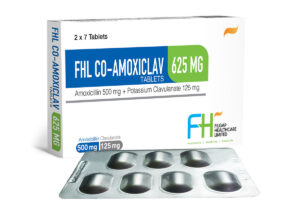
FHL CO-AMOXICLAV 625mg TABLETS
Amoxicillin 500mg + Potassium Clavulanate 125mg
COMPOSITION:
Each film coated tablet contains:
Amoxicillin Trihydrate BP
equivalent to Amoxicillin ………. 500 mg
Potassium Clavulanate BP
(As diluted Potassium Clavulanate BP)
equivalent to Clavulanic Acid …125 mg
Excipients ………………………………..q.s.
Colour: Titanium Dioxide BP
PHARMACOLOGICAL ACTION
Amoxicillin is semisynthetic penicillin (beta-lactam antibiotic) that inhibits one or more enzymes (often referred to as penicillin-binding proteins, PBPs) in the biosynthetic pathway of bacterial peptidoglycan, which is an integral structural component of the bacterial cell wall. Inhibition of peptidoglycan synthesis leads to weakening of the cell wall, which is usually followed by cell lysis and death.
Amoxicillin is susceptible to degradation by beta-lactamases produced by resistant bacteria and therefore the spectrum of activity of amoxicillin alone does not include organisms which produce these enzymes.
Clavulanic acid is a beta-lactam structurally related to penicillins. It inactivates some betalactamase enzymes thereby preventing inactivation of amoxicillin. Clavulanic acid alone does not exert a clinically useful antibacterial effect.
INDICATIONS
FHL Co-Amoxiclav tablets are indicated for the treatment of the following infections in adults and children:
- Acute bacterial sinusitis (adequately diagnosed)
- Acute otitis media
- Acute exacerbations of chronic bronchitis (adequately diagnosed)
- Community acquired pneumonia
- Cystitis
- Pyelonephritis
- Skin and soft tissue infections including cellulitis, animal bites, severe dental abscess with spreading cellulitis.
- Bone and joint infections, in particular osteomyelitis.
CONTRAINDICATIONS
Amoxicillin is contraindicated in patients with hypersensitivity to the active substances, to any of the penicillins or to any of the excipients.
It is also contraindicated in patients with a previous history of severe immediate hypersensitivity reaction (e.g. anaphylaxis) to another beta-lactam agent (e.g. cephalosporin, carbapenem or monobactam). It is also contraindicated in patients with a previous history of jaundice/hepatic impairment associated with amoxicillin and potassium clavulanate.
WARNINGS
Concerns related to adverse effects:
- Anaphylactoid/hypersensitivity reactions: Serious and occasionally severe or fatal hypersensitivity (anaphylactoid) reactions have been reported in patients on penicillin therapy, especially with a history of beta-lactam hypersensitivity, history of sensitivity to multiple allergens, or previous IgE-mediated reactions (e.g. anaphylaxis, angioedema, urticaria). Use with caution in asthmatic patients. Low incidence of cross-allergy with cephalosporins exists.
- Diarrhea: Incidence of diarrhea is higher than with amoxicillin alone.
- Hepatic effects: Although rare, hepatic dysfunction is more common in elderly and/or males, and occurs more frequently with prolonged treatment, and may occur after therapy is complete.
- Superinfection: Prolonged use may result in fungal or bacterial superinfection, including C. difficile-associated diarrhea (CDAD) and pseudomembranous colitis; CDAD has been observed >2 months post-antibiotic treatment.
- Hepatic impairment: Use with caution in patients with hepatic impairment.
- Infectious mononucleosis: A high percentage of patients with infectious mononucleosis have developed rash during therapy; ampicillin-class antibiotics not recommended in these patients.
- Renal impairment: Use with caution in patients with renal impairment; dosage adjustment recommended.
Dosage form specific issues:
- Clavulanic acid content: Due to differing content of clavulanic acid, not all formulations are interchangeable.
- Phenylalanine: Some products contain phenylalanine.
GENERAL PRECAUTIONS:
While amoxicillin and potassium clavulanate possesses the characteristic low toxicity of the penicillin group of antibiotics, periodic assessment of organ system functions, including renal, hepatic, and hematopoietic function, is advisable during prolonged therapy.
A high percentage of patients with mononucleosis who receive ampicillin develop an erythematous skin rash. Thus, ampicillin-class antibiotics should not be administered to patients with mononucleosis. The possibility of superinfections with mycotic or bacterial pathogens should be kept in mind during therapy. If superinfections occur (usually involving Pseudomonas or Candida), the drug should be discontinued and/or appropriate therapy instituted.
Prescribing amoxicillin and potassium clavulanate in the absence of a proven or strongly suspected bacterial infection or a prophylactic indication is unlikely to provide benefit to the patient and increases the risk of the development of drug-resistant bacteria.
DOSAGE AND ADMINISTRATION
Route of administration: Oral
FHL AMOXICILLIN AND POTASSIUM CLAVULANATE TABLETS 625 MG
- Adults and children ≥ 40kg – One 500mg/125mg dose taken three times daily
- Children ≤ 40kg – 20 mg/5 mg/kg/day to 60 mg/15 mg/kg/day given in three divided doses. No clinical data are available on doses of amoxicillin/clavulanic acid 4:1 formulations higher than 40 mg/ 10mg/kg per day in children under 2 years.
- Elderly – No dose adjustment is considered necessary.
FHL AMOXICILLIN AND POTASSIUM CLAVULANATE TABLETS 1G
Usual dosages for the treatment of infection
Adults and children over 12 years:
Severe infections – One Amoxicillin and Potassium Clavulanate 1 g Tablet twice daily
Dosage in renal impairment
Adults: The One Amoxicillin and Potassium Clavulanate 1 g Tablet should only be used in patients with a glomerular filtration rate of >30ml/ min.
| Mild impairment (Creatinine
clearance >30ml/min) |
Moderate impairment (Creatinine clearance 10-30ml/min) | Severe impairment (Creatinine clearance) |
| No change in dosage (i.e. one
1 g tablet twice daily) |
The 1g tablet should not be administered | Not more than one 625mg tablet every 24 hours. |
Dosage in hepatic impairment
Dose with caution; monitor hepatic function at regular intervals.
Administration
Tablets should be swallowed whole without chewing. If required, tablets may be broken in half and swallowed without chewing. To minimise potential gastrointestinal intolerance, administer at the start of a meal. The absorption of Amoxicillin and Potassium Clavulanate Tablets is optimised when taken at the start of a meal. Treatment should not be extended beyond 14 days without review.
SIDE EFFECTS AND SPECIAL PRECAUTIONS
Amoxicillin and clavulanate potassium is generally well tolerated. The majority of side effects observed in clinical trials were of a mild and transient nature and less than 3% of patients discontinued therapy because of drug-related side effects. The most frequently reported adverse effects were diarrhea/loose stools (9%), nausea (3%), skin rashes and urticaria (3%), vomiting (1%) and vaginitis (1%). The overall incidence of side effects, and in particular diarrhea, increased with the higher recommended dose. Other less frequently reported reactions include: Abdominal discomfort, flatulence, and headache.
The following adverse reactions have been reported for ampicillin-class antibiotics:
Gastrointestinal: Diarrhea, nausea, vomiting, indigestion, gastritis, stomatitis, glossitis, black “hairy” tongue, mucocutaneous candidiasis, enterocolitis, and hemorrhagic / pseudomembranous colitis. Onset of pseudomembranous colitis symptoms may occur during or after antibiotic treatment.
Hypersensitivity Reactions: Skin rashes, pruritus, urticaria, angioedema, serum sickness like reactions (urticaria or skin rash accompanied by arthritis, arthralgia, myalgia, and frequently fever), erythema multiforme (rarely Stevens-Johnson syndrome), acute generalized exanthematous pustulosis, hypersensitivity vasculitis, and an occasional case of exfoliative dermatitis (including toxic epidermal necrolysis) have been reported. These reactions may be controlled with antihistamines and, if necessary, systemic corticosteroids. Whenever such reactions occur, the drug should be discontinued, unless the opinion of the physician dictates otherwise. Serious and occasional fatal hypersensitivity (anaphylactic) reactions can occur with oral penicillin.
Liver: A moderate rise in AST (SGOT) and/or ALT (SGPT) has been noted in patients treated with ampicillin-class antibiotics, but the significance of these findings is unknown. Hepatic dysfunction, including hepatitis and cholestatic jaundice, increases in serum transaminases (AST and/or ALT), serum bilirubin and/or alkaline phosphatase, has been infrequently reported with amoxicillin and potassium clavulanate. It has been reported more commonly in the elderly, in males, or in patients on prolonged treatment. The histologic findings on liver biopsy have consisted of predominantly cholestatic, hepatocellular, or mixed cholestatic-hepatocellular changes. The onset of signs/symptoms of hepatic dysfunction may occur during or several weeks after therapy has been discontinued. The hepatic dysfunction, which may be severe, is usually reversible. On rare occasions, deaths have been reported (less than 1 death reported per estimated 4 million prescriptions worldwide). These have generally been cases associated with serious underlying diseases or concomitant medications.
Renal: Interstitial nephritis and hematuria have been reported rarely. Crystalluria has also been reported.
Hemic and Lymphatic System: Anemia, including hemolytic anemia, thrombocytopenia, thrombocytopenic purpura, eosinophilia, leukopenia, and agranulocytosis have been reported during therapy with penicillins. These reactions are usually reversible on discontinuation of therapy and are believed to be hypersensitivity phenomena. A slight thrombocytosis was noted in less than 1% of the patients treated with amoxicillin and potassium clavulanate. There have been reports of increased prothrombin time in patients receiving amoxicillin and potassium clavulanate and anticoagulant therapy concomitantly.
Central Nervous System: Agitation, anxiety, behavioral changes, confusion, convulsions, dizziness, insomnia, and reversible hyperactivity have been reported rarely.
Miscellaneous: Tooth discoloration (brown, yellow, or gray staining) has been rarely reported. Most reports occurred in pediatric patients. Discoloration was reduced or eliminated with brushing or dental cleaning in most cases.
DRUG INTERACTIONS
Allopurinol: May enhance the potential for allergic or hypersensitivity reactions to Amoxicillin.
Risk C: Monitor therapy.
Fusidic Acid: May diminish the therapeutic effect of Penicillins.
Risk D: Consider therapy modification.
Methotrexate: Penicillins may decrease the excretion of Methotrexate.
Risk C: Monitor therapy.
Mycophenolate: Penicillins may decrease serum concentrations of the active metabolite(s) of Mycophenolate. This effect appears to be the result of impaired enterohepatic recirculation.
Risk C: Monitor therapy
Tetracycline Derivatives: May diminish the therapeutic effect of Penicillins.
Risk D: Consider therapy modification.
Typhoid Vaccine: Antibiotics may diminish the therapeutic effect of Typhoid Vaccine. Only the live attenuated Ty21a strain is affected.
Risk D: Consider therapy modification.
Uricosuric Agents: May decrease the excretion of Penicillins.
Risk C: Monitor therapy.
OVERDOSAGE:
Following overdosage, patients have experienced primarily gastrointestinal symptoms including stomach and abdominal pain, vomiting, and diarrhea. Rash, hyperactivity, or drowsiness have also been observed in a small number of patients.
In the case of overdosage, discontinue amoxicillin / clavulanate potassium, treat symptomatically, and institute supportive measures as required. If the overdosage is very recent and there is no contraindication, an attempt at emesis or other means of removal of drug from the stomach may be performed. A prospective study of 51 pediatric patients at a poison center suggested that overdosages of less than 250 mg/kg of amoxicillin are not associated with significant clinical symptoms and do not require gastric emptying.
STORAGE
Store below 30°C. Protect from light and moisture. Keep medicine out of reach of children.
PRESENTATION
Alu Alu blister of 7 tablets. 2 of such blisters in a printed carton along with pack insert.
